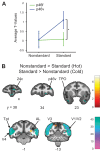Different Subregions of Monkey Lateral Prefrontal Cortex Respond to Abstract Sequences and Their Components
- PMID: 39379151
- PMCID: PMC11580767
- DOI: 10.1523/JNEUROSCI.1353-24.2024
Different Subregions of Monkey Lateral Prefrontal Cortex Respond to Abstract Sequences and Their Components
Abstract
Sequential information permeates daily activities, such as when watching for the correct series of buildings to determine when to get off the bus or train. These sequences include periodicity (the spacing of the buildings), the identity of the stimuli (the kind of house), and higher-order more abstract rules that may not depend on the exact stimulus (e.g., house, house, house, business). Previously, we found that the posterior fundus of area 46 in the monkey lateral prefrontal cortex (LPFC) responds to rule changes in such abstract visual sequences. However, it is unknown if this region responds to other components of the sequence, i.e., image periodicity and identity, in isolation. Further, it is unknown if this region dissociates from other, more ventral LPFC subregions that have been associated with sequences and their components. To address these questions, we used awake functional magnetic resonance imaging in three male macaque monkeys during two no-report visual tasks. One task contained abstract visual sequences, and the other contained no visual sequences but maintained the same image periodicity and identities. We found the fundus of area 46 responded only to abstract sequence rule violations. In contrast, the ventral bank of area 46 responded to changes in image periodicity and identity, but not changes in the abstract sequence. These results suggest a functional specialization within anatomical substructures of LPFC to signal different kinds of stimulus regularities. This specialization may provide key scaffolding to identify abstract patterns and construct complex models of the world for daily living.
Keywords: abstract sequence; fMRI; nonhuman primate; prefrontal cortex.
Copyright © 2024 the authors.
Conflict of interest statement
The authors declare no competing financial interests.
Figures





Update of
-
Different subregions of monkey lateral prefrontal cortex respond to abstract sequences and their components.bioRxiv [Preprint]. 2024 Sep 11:2024.02.13.580192. doi: 10.1101/2024.02.13.580192. bioRxiv. 2024. Update in: J Neurosci. 2024 Nov 20;44(47):e1353242024. doi: 10.1523/JNEUROSCI.1353-24.2024. PMID: 38405897 Free PMC article. Updated. Preprint.
References
-
- Balan PF, Zhu Q, Li X, Niu M, Rapan L, Funck T, Wang H, Bakker R, Palomero-Gallagher N, Vanduffel W (2024) MEBRAINS 1.0: a new population-based macaque atlas. Imaging Neurosci 2:1–26. 10.1162/imag_a_00077 - DOI
-
- Brett M, Anton JL, Valabregue R, Poline JB (2002) Region of interest analysis using an SPM toolbox. In: 8th international conference on functional mapping of the human brain 16:497.
MeSH terms
Grants and funding
LinkOut - more resources
Full Text Sources
